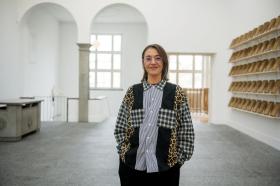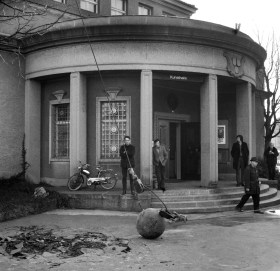Art
New director of Bern's main art space wants to start a conversation – SWI swissinfo.ch in English
In May, South African curator Kabelo Malatsie arrived in Switzerland to run one of Bern’s main art institutions, the Kunsthalle. SWI swissinfo.ch met her to talk about her concept of curating and what she thinks should change in the art world.
This content was published on July 10, 2022 – 10:00
Aoife Rosenmeyer
The appointment of South African curator Kabelo Malatsie to succeed Valérie Kroll as head of the Kunsthalle was intriguing. Not only is she the first non-European to head a public Swiss art institution, the former Johannesburg resident also followed an unusual career path.
Malatsie first studied marketing management before moving to art history and ultimately curating. She began her professional life in the arts as acting director of the Stevenson in Cape Town, a commercial gallery, before bringing her expertise to an artists’ rights organisation. She is best known curatorially for her work within the Yokohama Triennial 2020 (Japan). She was asked by the curators of the Raqs Media Collective, Michelle Wong and Lantian Xie, to curate a discrete and complex programme called Deliberations on Discursive Justice.
Her appointment as the new head of the Kunsthalle – an art space without a permanent collection – is part of the institution’s long disruptive tradition. In the 1960s, it was the epicentre of radical experiments led by its head Harald Szeemann – which eventually cost him his job. Decades later, in 2015, the Kunsthalle appointed a woman for the first time to head the institution, Valérie Knoll. Malatsie, as a non-European, brings to Bern a new perspective on what curating and art spaces can mean.
SWI swissinfo.ch: You’ve scarcely had time to unpack your bags. How do you intend to explore the city of Bern and its arts scene?
Kabelo Malatsie: I’m letting people who have been working in this space and who live in Bern help me navigate it. I will be walking a lot.
SWI: In the art world, the Kunsthalle Bern is known for experimentation in the contemporary field; nonetheless, Bern is quite conservative. How do you perceive your audience?
K.M.: To be truthful, I haven’t yet met the audience. It would be disingenuous for me to say that I’m going to curate with the audience in mind. My approach is to do shows that I’m interested in and hope that this will generate conversations. This is what I’m interested in: having a platform for ideas and a more dialogic approach to curatorial practice rather than ‘I’ll show you something that is finished and closed’, closing off any potential for feedback and conversation.
The other thing that I’m interested in is working with young people, especially for them to challenge the Kunsthalle. Even though it’s known for experimentation, I’m sure it’s now old and institutional, and [this condition] can stifle critique.
SWI: What was the appeal for you to work in the Kunsthalle?
K.M.: It’s somewhat of an empty container; it has no permanent collection and as a director, it comes down to your own curatorial interest to fill the space. Though we will be working with artists over a relatively short time, it would be great if we can define working models we can test out together, and that artists can take with them in their future work.
SWI: You once remarked that your early conception of curating was putting objects on walls. How has that concept expanded since?
K.M.: At the beginning of my understanding of curatorial practice I was thinking more along museum curating, which can be very conservative. Now I think that even administrative work can be curatorial. One can think about Excel spreadsheets creatively, and go beyond balancing money; we can think of different resources that go into making an exhibition.
When you’re doing a project you start ambitiously, conceptually, then the concept starts sinking when day-to-day issues take over. I’m hoping that, as the administrator, I can encourage a working practice where the conceptual stakes are always high and I am not reducing concepts and getting bogged down by practicalities.
SWI: How would you define an art space?
K.M.: Creativity is everywhere. Space for art is everywhere. I read an interview a long time ago where [Brazilian artist] Paulo Nazareth said that even if he stopped making art objects and was a fisherman, he would still be an artist as a fisherman. The curatorial practice can go into multiple directions.
SWI: I can understand your perspective, but is a gallery, or a museum, still the privileged space for art?
K.M.: There’s the old-fashioned Western way of doing things: things are [categorised] in neat boxes. This is where we have art, this is where we have medicine and so on. (When I mean Western, I mean colonised places as well.) So, in South Africa things are in boxes, too, more so in formal institutions.
For me these boundaries are no longer important, so long as what you’re doing makes sense. A good example is Stephen Alexander, a physicist and a jazz musician; you can be thinking about scientific questions whilst doing an artistic activity. So, I am not really caught up in defining what is curating, or what is art.
SWI: I guess we’ll have to see what happens in the Kunsthalle…
K.M.: There will be art objects, there’ll be performances. There are a set of questions that I’m trying to answer with each exhibition. Each work will be trying, not to answer, but to grapple with a question that I have.
SWI: For many art institutions and galleries Covid-19 meant slowing down and a refocusing on how exhibitions are produced and mediated. Did this affect your thinking?
K.M.: When museum and exhibition spaces were closed, the art world was putting their artworks online, and there was nostalgia for being in a physical exhibition space. And I was thinking back to the conceptual art of the ‘60s and ‘70s and how the idea was more important than the object. The idea of moving from the fixation with the art object, into a space of ideas, hasn’t really evolved since.
If we are closing galleries and exhibition spaces, then the ideas should really be able to live on. There was this dissonance around the art object’s importance and that the object carries ideas beyond the fact that it is an object. Some of the online interventions were trying to recreate the exhibition space. I felt like we were missing an opportunity to push the idea introduced by conceptual artists many years ago.
Whereas the music scene has always been able to adapt to every technological change without losing its essence. Art, on the other hand, seems stuck technologically, it doesn’t move.
SWI: I fear that it is hampered by the market.
K.M.: Yes, but the thing about the market is that it’s such a small group of people.
SWI: But it’s often the way that art gets in the public eye.
K.M.: We need to find a way out, no? Otherwise, we have to accept that things don’t move.
Edited by Eduardo Simantob

In compliance with the JTI standards
More: SWI swissinfo.ch certified by the Journalism Trust Initiative
Art
Ukrainian sells art in Essex while stuck in a warzone – BBC.com
[unable to retrieve full-text content]
Ukrainian sells art in Essex while stuck in a warzone BBC.com

Source link
Art
Somerset House Fire: Courtauld Gallery Reopens, Rest of Landmark Closed
The Courtauld Gallery at Somerset House has reopened its doors to the public after a fire swept through the historic building in central London. While the gallery has resumed operations, the rest of the iconic site remains closed “until further notice.”
On Saturday, approximately 125 firefighters were called to the scene to battle the blaze, which sent smoke billowing across the city. Fortunately, the fire occurred in a part of the building not housing valuable artworks, and no injuries were reported. Authorities are still investigating the cause of the fire.
Despite the disruption, art lovers queued outside the gallery before it reopened at 10:00 BST on Sunday. One visitor expressed his relief, saying, “I was sad to see the fire, but I’m relieved the art is safe.”
The Clark family, visiting London from Washington state, USA, had a unique perspective on the incident. While sightseeing on the London Eye, they watched as firefighters tackled the flames. Paul Clark, accompanied by his wife Jiorgia and their four children, shared their concern for the safety of the artwork inside Somerset House. “It was sad to see,” Mr. Clark told the BBC. As a fan of Vincent Van Gogh, he was particularly relieved to learn that the painter’s famous Self-Portrait with Bandaged Ear had not been affected by the fire.
Blaze in the West Wing
The fire broke out around midday on Saturday in the west wing of Somerset House, a section of the building primarily used for offices and storage. Jonathan Reekie, director of Somerset House Trust, assured the public that “no valuable artefacts or artworks” were located in that part of the building. By Sunday, fire engines were still stationed outside as investigations into the fire’s origin continued.
About Somerset House
Located on the Strand in central London, Somerset House is a prominent arts venue with a rich history dating back to the Georgian era. Built on the site of a former Tudor palace, the complex is known for its iconic courtyard and is home to the Courtauld Gallery. The gallery houses a prestigious collection from the Samuel Courtauld Trust, showcasing masterpieces from the Middle Ages to the 20th century. Among the notable works are pieces by impressionist legends such as Edouard Manet, Claude Monet, Paul Cézanne, and Vincent Van Gogh.
Somerset House regularly hosts cultural exhibitions and public events, including its popular winter ice skating sessions in the courtyard. However, for now, the venue remains partially closed as authorities ensure the safety of the site following the fire.
Art lovers and the Somerset House community can take solace in knowing that the invaluable collection remains unharmed, and the Courtauld Gallery continues to welcome visitors, offering a reprieve amid the disruption.
Art
Sudbury art, music festival celebrating milestone

Sudbury’s annual art and music festival is marking a significant milestone this year, celebrating its long-standing impact on the local cultural scene. The festival, which has grown from a small community event to a major celebration of creativity, brings together artists, musicians, and visitors from across the region for a weekend of vibrant performances and exhibitions.
The event features a diverse range of activities, from live music performances to art installations, workshops, and interactive exhibits that highlight both emerging and established talent. This year’s milestone celebration will also honor the festival’s history by showcasing some of the artists and performers who have contributed to its success over the years.
Organizers are excited to see how the festival has evolved, becoming a cornerstone of Sudbury’s cultural landscape. “This festival is a celebration of creativity, community, and the incredible talent we have here in Sudbury,” said one of the event’s coordinators. “It’s amazing to see how it has grown and the impact it continues to have on the arts community.”
With this year’s milestone celebration, the festival promises to be bigger and better than ever, with a full lineup of exciting events, workshops, and performances that will inspire and engage attendees of all ages.
The festival’s milestone is not just a reflection of its past success but a celebration of the continued vibrancy of Sudbury’s arts scene.

-

 News17 hours ago
News17 hours agoSingh claps back at Poilievre ahead of House return
-

 News22 hours ago
News22 hours agoArrest made in death of man whose body was found four years ago: police
-

 News16 hours ago
News16 hours agoMore than 67 million people watched Donald Trump and Kamala Harris debate. That’s way up from June
-

 News16 hours ago
News16 hours agoTaxi driver suspected in fatal B.C. hit-and-run has left Canada: RCMP
-

 News23 hours ago
News23 hours ago‘Concerning’ number of impaired drivers arrested in roads in Saanich, B.C.: police
-

 News6 hours ago
News6 hours agoReggie Bush was at his LA-area home when 3 male suspects attempted to break in
-

 News24 hours ago
News24 hours agoExperts say Harris dominated in debate performance against Trump
-

 News16 hours ago
News16 hours agoThe ancient jar smashed by a 4-year-old is back on display at an Israeli museum after repair
























